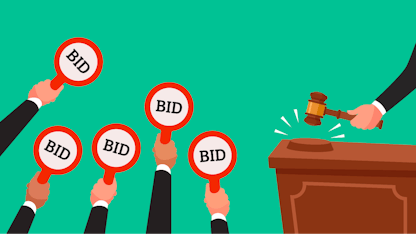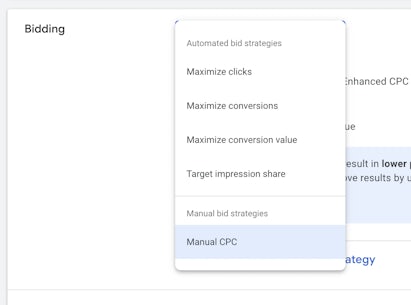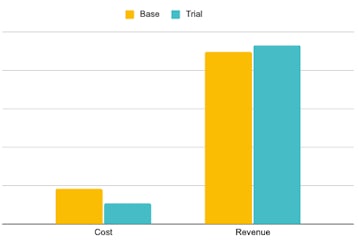With huge advances in automation, it’s no surprise that marketers are rapidly switching over to automated bidding completely in PPC, but is this always the best approach or is there an argument for ‘old-school’ manual bidding?
Google has certainly been promoting automation, not just through bid strategies, but also through Dynamic Search Ads, Responsive Search Ads & Performance Max, to name a few. Successful testing of these new features and smart bidding, which Google convincingly describes as ‘the power of automated bidding’, have made it hugely compelling to make the full transition.
“Google Ads automated bidding takes much of the heavy lifting and guesswork out of setting bids to meet your performance goals. Conversion-based bidding is powered by auction-time technology, optimising bids with precision on actual search queries for each and every auction. It also factors in a wide range of auction-time signals including device, location, time of day, language and operating system to capture the unique context of every search.” – Google Support Answers
We’ve seen incredible results and there’s undoubtedly a time and a place to use a range of bid strategies. Below are the smart bid strategies currently available in Google Ads:
- Target impression share
- Target cost of action (CPA)
- Target return on ad spend (ROAS)
- Maximise conversions
- Maximise conversion value
- Maximise clicks
- Enhanced cost per click (eCPC)
Understanding the best bid strategy for your objectives
When it comes to pure brand activity, automation might not always be the best option. You might be asked to maximise pure brand visibility. Understandably, as this is not only highly likely to be the most efficient and profitable, but also it’s fundamental to protect your brand image. It’s often vital to maintain the top spot in the SERP for key pure brand terms, not allowing a competitor or re-seller ad to dominate. This has only increased in importance over the years with increasing mobile sessions, and the visibility on a smaller mobile screen being harder to come by.
Target impression share is the obvious choice to maximise visibility, the bid strategy automatically sets bids with the goal of showing your ad on the absolute top-of-page, top-of-page, or anywhere on the search results page, depending on the percentage impression share chosen. This means the bid will fluctuate based on changes in competitor bidding to ensure the desired impression share is met.
Campaign structure is also fundamental to maximising performance. With the emphasis on consolidation to achieve a modern search structure going hand in hand with automation. The idea is that the fewer the campaigns the higher the data density through each campaign and the better the automated bid strategies will be able to work, and the faster they can learn.

Segmenting exact & phrase match terms
We initially set up our pure brand campaign with a target impression share strategy with the campaign containing both exact and phrase match keywords. However, we found that the bid strategy was funnelling a large proportion of spend into phrase match visibility where ROAS was lower compared to efficient exact match terms.
This meant that we were faced with campaigns being limited by budget and therefore not achieving the desired target impression share percentage or visibility targets, whilst there was a lot of room to improve efficiency too. Given budget limitations and ROAS objectives we opted to test splitting out exact and phrase match terms to gain greater control.
This meant we could go after exact match impression share while utilising Google’s intent signals through bid strategies to improve ad intent and gain a healthier return on phrase match keywords. Initial testing was very successful; we were able to increase exact match impression share without negatively impacting conversions. As a result, this enabled us to push more budget into increasing brand visibility through Performance Max since blended ROAS targets were being met by more efficient brand search activity.
Our approach to testing target impression share vs. manual bidding
As we dived deeper into brand search volume, impression share, auction insights and CPCs year on year it became increasingly difficult to explain increased CPCs and reduced competition year on year.
While CPC inflation is a consideration, we began to question if the target impression share strategy was inflating CPCs unnecessarily. We looked to manual bidding as a potential solution to maintain pure brand visibility while increasing efficiency. Manual CPC bidding offered the ability to control our maximum CPC for core brand keywords while ensuring a strong brand presence. By segmenting the pure brand exact match campaign, we could apply a high maximum CPC to the most efficient pure brand keywords. Meanwhile, performance through phrase match keywords improved by utilising Google’s intent signals to make sure the campaign was being optimised for conversion value overlaid with a target ROAS for these broader branded terms.

The results
Using Google’s experiments, testing was carried out using a traffic split test of 50/50 and the outcome was overwhelming in favour of greater efficiency for the trial campaign. With an equal number of clicks driven to the site, we saw the average CPC drop by a staggering 43%, while conversions and conversion value were higher for the trial campaign. This resulted in a huge 79% increase in ROAS. Several incremental increases in max CPCs throughout helped boost Impression Share when it was falling below the base campaign. Ultimately by using this technique, we’ve been able to gain a huge amount more control over spend and visibility which will allow us to better prioritise spending to align with budgets and objectives in future. For this specific case, we’ve been able to achieve visibility and ROAS targets by managing to spend more efficiently which has enabled us to get the most out of our budget and increase traffic through more upper-funnel campaign types. This may be something that you might want to trail with your brand’s campaigns too.
We’ve begun expanding testing further where similar situations are present. However, when it comes to automated bidding it’s important to understand your goals, budgets, and historic behaviour when considering what account structure and bid strategies to adopt. From there a rigorous test-and-learn approach will determine how your account is best optimised, as account nuances mean that unfortunately, it’s not the case of taking a one-size-fits-all approach.
It’s unclear how much longer manual bidding will be available to us, but in the meantime, there’s a great opportunity to increase efficiency by testing manual bidding across core exact brand terms. Automation is inescapable, and rightfully so! But maybe we shouldn’t be so quick to ditch manual CPC in all instances.

Want to read more useful PPC tips and advice that you can use for your own brand from the team at Impression? Be sure to check out more PPC blogs. If you have any questions about how we’ve been able to leverage ‘old school’ PPC bidding, get in touch.



